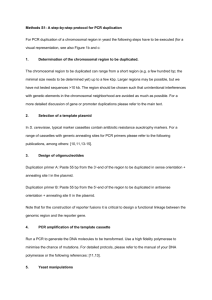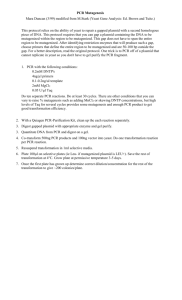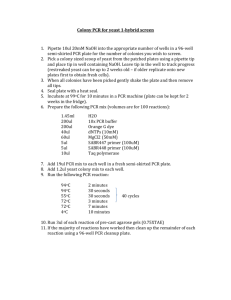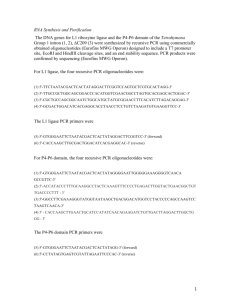Supplementary Methods
advertisement
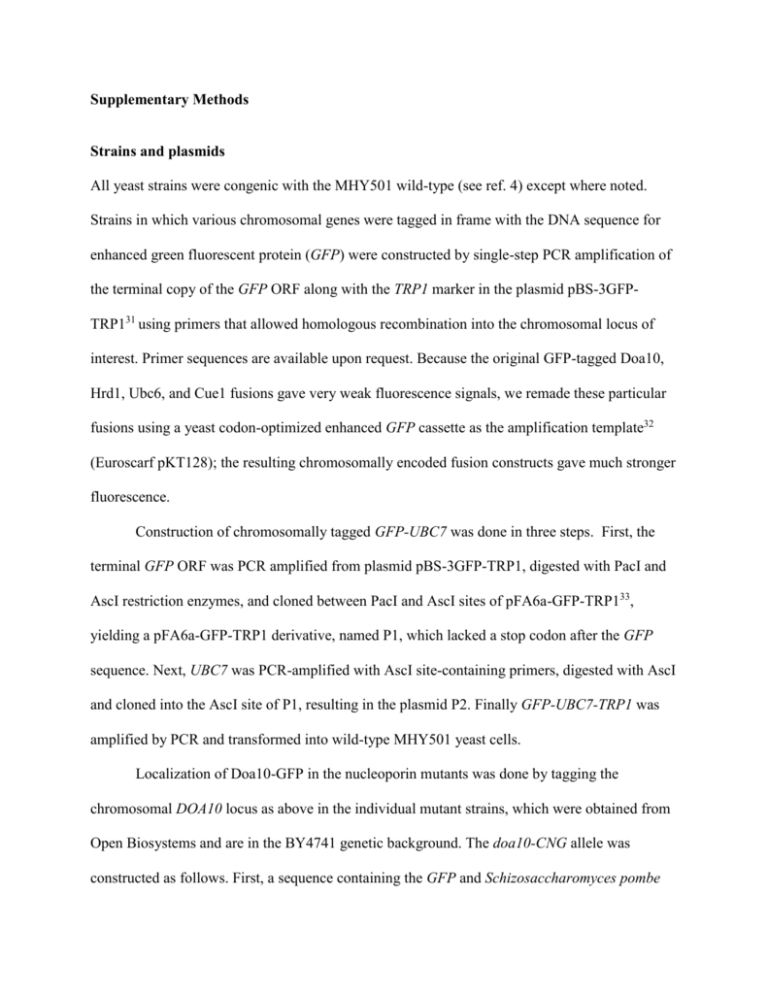
Supplementary Methods Strains and plasmids All yeast strains were congenic with the MHY501 wild-type (see ref. 4) except where noted. Strains in which various chromosomal genes were tagged in frame with the DNA sequence for enhanced green fluorescent protein (GFP) were constructed by single-step PCR amplification of the terminal copy of the GFP ORF along with the TRP1 marker in the plasmid pBS-3GFPTRP131 using primers that allowed homologous recombination into the chromosomal locus of interest. Primer sequences are available upon request. Because the original GFP-tagged Doa10, Hrd1, Ubc6, and Cue1 fusions gave very weak fluorescence signals, we remade these particular fusions using a yeast codon-optimized enhanced GFP cassette as the amplification template32 (Euroscarf pKT128); the resulting chromosomally encoded fusion constructs gave much stronger fluorescence. Construction of chromosomally tagged GFP-UBC7 was done in three steps. First, the terminal GFP ORF was PCR amplified from plasmid pBS-3GFP-TRP1, digested with PacI and AscI restriction enzymes, and cloned between PacI and AscI sites of pFA6a-GFP-TRP133, yielding a pFA6a-GFP-TRP1 derivative, named P1, which lacked a stop codon after the GFP sequence. Next, UBC7 was PCR-amplified with AscI site-containing primers, digested with AscI and cloned into the AscI site of P1, resulting in the plasmid P2. Finally GFP-UBC7-TRP1 was amplified by PCR and transformed into wild-type MHY501 yeast cells. Localization of Doa10-GFP in the nucleoporin mutants was done by tagging the chromosomal DOA10 locus as above in the individual mutant strains, which were obtained from Open Biosystems and are in the BY4741 genetic background. The doa10-CNG allele was constructed as follows. First, a sequence containing the GFP and Schizosaccharomyces pombe his5+ genes was amplified from the plasmid pFA6a-link-yEGFP-SpHIS532, and the product was integrated into the CRN1 locus in yeast by homologous recombination and selection on SD–His plates; in-frame fusion of the GFP moiety after codon 400 of CRN1 was confirmed by PCR. Using genomic DNA from this strain as PCR template, a DNA sequence containing CRN1 codons 1-400 fused to GFP followed by the his5+ gene was amplified. The resulting DNA fragment was transformed into MHY501 cells where it integrated in-frame after the DOA10 ORF, as confirmed by PCR and Western analysis. Doa10N-GFP (Doa10-N) was constructed by PCR amplification of the codon-optimized GFP ORF along with HIS5sp marker in the plasmid pFA6a-link-EGFP-HIS5sp (Euroscarf pKT128) using primers that allowed homologous recombination after codon 950 of DOA10. Doa10C-GFP (Doa10-C) was constructed by PCR amplification of TRP1-PGAL1 from pFA6aTRP-PGAL1 (Euroscarf) and inserting the fragment by homologous recombination upstream of codon 951 of DOA10-GFP. A start codon was also provided. Construction of a strain expressing Doa10-Pgk1-GFP was constructed in two steps. First, the GFP ORF along with the HIS5sp marker was PCR-amplified from plasmid pFA6a-link-EGFP-HIS5sp using primers that allowed homologous recombination into the PGK1 gene just upstream of its stop codon. Next, the fragment consisting of PGK1-GFP-HIS5sp was PCR-amplified from the genomic DNA of the resulting strain. This DNA fragment was inserted at the 3’ end of the chromosomal DOA10 ORF by in vivo recombination. A strain with a chromosomal fusion encoding Doa10-Hrd1C was made by PCR amplifying a DNA fragment encoding Hrd1 residues 219-551 and GFP from the HRD1-GFP strain (described above) and inserting it at the 3’ end of the DOA10 ORF by homologous recombination in yeast. Plasmid GBD-Doa10-Myc was constructed by first PCR amplifying the DOA10 ORF, plus an in-frame 13xMYC epitope sequence present at its 3’ end, from the genomic DNA of yeast strain MHY2888, which carries a chromosomal DOA10-MYC allele2. The PCR product was then cotransformed along with BamHI-linearized pMA424 plasmid28 into yeast strain YSB35. Correct recombination between the PCR fragment and vector was confirmed by DNA sequencing and Western analysis. Protein degradation assayed by gal activity loss Activity-chase analyses of Deg1-gal degradation were done by addiing cycloheximide and measuring disappearance of gal activity with ONPG substrate as described29. Activity loss closely parallels protein degradation as determined by immunoblot and pulse-chase analyses11 (M.D. and M.H., unpublished). Cells were grown to OD600 ~1 and culture aliquots (0.6 OD600 equivalents) were taken at various time points. Cells were pelleted and then resuspended in 300 l lysis buffer (0.6% Triton X-100, 0.75% ONPG, 2.25% -mercaptoethanol, 0.15 M Tris-HCl pH 7.5), vortexed and placed at –80oC for at least 30 min. Samples were thawed and incubated at 37oC to follow gal cleavage of ONPG. 150 l of 1M Na2CO3 was added to stop the reaction, and cell debris was removed by centrifugation. Samples were diluted, and absorbance at 420 nm was measured. Chromatin immunoprecipitation (ChIP) analysis Chromatin was prepared and immunoprecipitation was performed as described previously34. Anti-Gal4 (Abcam Inc.) or anti-Myc (Covance) antibodies were used for immunoprecipitation. PCR primers were chosen to amplify either UASG or the promoter region of DOA3 (-381 to 113). Fluorescence microscopy Immunofluorescence microscopy was performed as described35. Primary antibody incubations were performed in PBS containing 0.5% BSA. gal was detected using anti-gal antibody (Promega) and Alexa Fluor 488 conjugated anti-mouse antibody (Molecular Probes). Images were taken on an Axioscope 2 microscope (Carl Zeiss Inc., Thornwood, NY) equipped with a Zeiss AxioCam (Cooke, Auburn, MI). Rhodamine-phalloidin staining of cells was performed as follows. Cells were grown to OD600 ~1 and fixed by resuspending the cell pellet in PBS containing 4% formaldehyde at room temperature for 1 h. After wash twice with PBS, 100 l of cells were incubated with 10 l rhodamine-phalloidin (6.6 M) in the dark for 1 h. After extensive washing with PBS, cells were processed for fluorescence microscopy. For confocal imaging of Doa10-GFP and Sec61-GFP, live cells were observed with a Plan-Apo 100X/1.4 NA objective on an UltraVIEW RS confocal microscope (Perkin Elmer Life and Analytical Sciences) using a 488-nm argon ion laser with a 525- 625 nm emission filter. Stacks of 0.2-m-thick optical sections were collected and images of the projected stacks were analyzed. Due to differences in protein levels, the exposure time for Sec61-GFP and Doa10-GFP were 0.3 sec and 1.6 sec, respectively. For regular fluorescence microscopy, Sec61-GFP and Doa10-GFP as well as other GFPtagged proteins were examined with an AxioCam-equipped Axioscope 2 microscope, using a GFP-optimized filter set (CZ909; Chroma Technology Corp., Brattleboro, VT). Exposure times were 1.6 sec for GFP-tagged Doa10, Hrd1, Ubc6, Ubc7, and Cue1 and 0.2 sec for GFP-Mga2. Quantitation of theta nuclei was done by counting both total cells and cells with theta nuclei in 20 random image fields, with total cell number of at least 150 for each sample. Three individual cultures of each sample were counted to obtain mean values and standard deviations.

